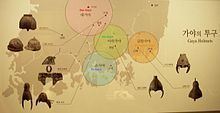Hangul 금관가야 Revised Romanization Geumgwan Gaya | Hanja 金官伽倻 McCune–Reischauer Kŭmgwan Kaya | |
 | ||
Korean history the first female warriors of geumgwan gaya 001
Geumgwan Gaya (43 - 532), also known as Bon-Gaya (본가야, 本伽倻, "original Gaya") or Garakguk (가락국, "Garak State"), was the ruling city-state of the Gaya confederacy during the Three Kingdoms Period in Korea. It is believed to have been located around the modern-day city of Gimhae, Southern Gyeongsang province, near the mouth of the Nakdong River. Due to its geographic location, this kingdom played a dominant role in the regional affairs from the Byeonhan period onward to the end of the Gaya confederacy.
Contents
- Korean history the first female warriors of geumgwan gaya 001
- Korean history the first female warriors of geumgwan gaya 002
- References
According to the Samguk Yusa, Geumgwan Kaya was made of 9 villages united by King Suro of Gaya. His wife and queen Heo Hwang-ok, whom he married in 48 AD, is believed to be a princess from the Ayodhya region in what is now India, although this may have been an embellishment made during later Buddhist times.
During this early time in the history of Gaya, several waves of migration from the north, including the earlier-extant Gojoseon, Buyeo, and the Goguryeo, arrived and integrated with existing populations and stimulated cultural and political developments. A sharp break in burial styles is found in archaeological sites dated near the late 3rd century AD, when these migrations are to have taken place. Burial forms associated with North Asian nomadic peoples, such as the burial of horses with the dead, suddenly replace earlier forms in the tombs of the elite (Cheol 2000). In addition, evidence exists indicating that earlier burials were systematically destroyed. In the early 1990s, a royal tomb complex was unearthed in Daeseong-dong, Gimhae, attributed to Geumgwan Gaya but apparently used since Byeonhan times.
After Geumgwan Gaya capitulated to Silla in 532 AD, its royal house was accepted into the Sillan aristocracy (probably because by that time, a major house of Silla, of the Gyeongju Kim clan, was related to the Gaya royal house, which was Gimhae Kim clan) and given the rank of "true bone," the second-highest level of the Silla bone rank system. General Kim Yu-shin of Silla (also of the Gimhae Kim clan) was a descendant of the last king of Gaya.
